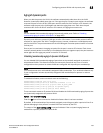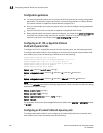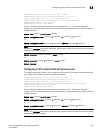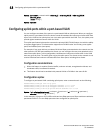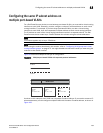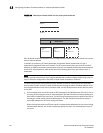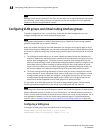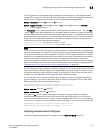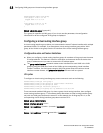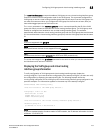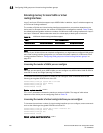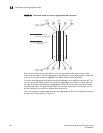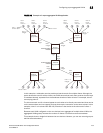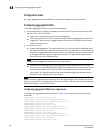
PowerConnect B-Series FCX Configuration Guide 473
53-1002266-01
Configuring VLAN groups and virtual routing interface groups
13
The first command in this example begins configuration for VLAN group 1, and assigns VLANs 2
through 257 to the group. The second command adds ports 1/1 and 1/2 as tagged ports. Because
all the VLANs in the group share the ports, you must add the ports as tagged ports.
Syntax: vlan-group <num> vlan <vlan-id> to <vlan-id>
Syntax: tagged ethernet [<slotnum>/]<portnum> [to [<slotnum>/]<portnum> | ethernet
[<slotnum>/]<portnum>]
The vlan-group <num> parameter specifies the VLAN group ID and can be from 1 – 32. The vlan
<vlan-id> to <vlan-id> parameters specify a contiguous range (a range with no gaps) of individual
VLAN IDs. Specify the low VLAN ID first and the high VLAN ID second. The command adds all of the
specified VLANs to the VLAN group. You can add up to 256 VLANs at a time. To add more than 256
VLANs, do so using separate commands. For example, to configure VLAN group 1 and add 512
VLANs to the group, enter the following commands:
PowerConnect(config)# vlan group 1 vlan 2 to 257
PowerConnect(config-vlan-group-1)# add vlan 258 to 514
NOTE
The device memory must be configured to contain at least the number of VLANs you specify for the
higher end of the range. For example, if you specify 2048 as the VLAN ID at the high end of the range,
you first must increase the memory allocation for VLANs to 2048 or higher. Additionally, on Layer 3
Switches, if you allocate additional memory for VLANs, you also need to allocate the same amount
of memory for virtual routing interfaces, before you configure the VLAN groups. This is true
regardless of whether you use the virtual routing interface groups. The memory allocation is required
because the VLAN groups and virtual routing interface groups have a one-to-one mapping. Refer to
“Allocating memory for more VLANs or virtual routing interfaces” on page 476.
If a VLAN within the range you specify is already configured, or if the range contains more than 256
VLANs, the CLI does not add the group but instead displays an error message. In this case, create
the group by specifying a valid contiguous range. Then add more VLANs to the group after the CLI
changes to the configuration level for the group. See the following example.
You can add and remove individual VLANs or VLAN ranges from at the VLAN group configuration
level. For example, if you want to add VLANs 1001 and 1002 to VLAN group 1 and remove VLANs
900 through 1000, enter the following commands.
PowerConnect(config-vlan-group-1)# add-vlan 1001 to 1002
PowerConnect(config-vlan-group-1)# remove-vlan 900 to 1000
Syntax: add-vlan <vlan-id> [to <vlan-id>]
Syntax: remove-vlan <vlan-id> [to <vlan-id>]
The <vlan-id> to <vlan-id> parameters specify a contiguous range (a range with no gaps) of
individual VLAN IDs. Specify the low VLAN ID first and the high VLAN ID second. You can add or
remove up to 256 VLANs at a time. To add or remove more than 256 VLANs, do so using separate
commands. For example, to remove 512 VLANs from VLAN group 1, enter the following commands.
PowerConnect(config-vlan-group-1)# remove-vlan 400 to 656
PowerConnect(config-vlan-group-1)# remove-vlan 657 to 913
Displaying information about VLAN groups
To display VLAN group configuration information, use the show vlan-group command.



